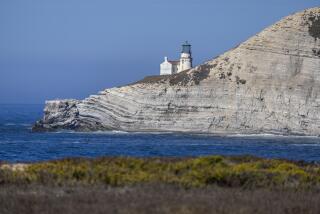Caretaker of Wildlife Island Refuge Finds He Enjoys Solitude : Puget Sound: Volunteer and his cat are the only residents other than birds, deer and harbor seals.
- Share via
PROTECTION ISLAND, Wash. — Steve Wiggins can never say his neighborhood has gone to the dogs.
But he can say it’s for the birds.
And out the back door, he says, is “Shangri-La”--a broad, hidden, wind-swept pasture nestled in the center of his neighborhood, Protection Island National Wildlife Refuge, nesting haven for three-quarters of Puget Sound’s sea birds.
Wiggins, 46, is the island’s caretaker. He and his cat are the only residents other than the birds, a few deer and harbor seals on the 440-acre island.
Life gets lonely, but solitude is a welcome companion.
“I enjoy it. I like the solitude,” said Wiggins, who was appointed over a few other applicants by the U.S. Fish and Wildlife Service to the one-year volunteer position.
“There’s a quietness. I can hear a dog barking on land (at Diamond Point, about two miles away),” Wiggins said.
He lives in a roomy A-frame with a view of the Olympics and Diamond Point. The house is one of few left on the island, which the federal government turned into a refuge in 1982. Wiggins works out of an office and several utility and storage sheds on the south side of the island.
He settled in Sequim about a year ago and plans to open a charter fishing resort in Alaska when his island tour is done.
The island went through numerous private owners between 1861, when the government gave it to three War of 1812 veterans, and 1968, when the Protection Island Co. bought it for $435,000 and planned to lay out hundreds of home sites. About a dozen vacation homes were built and five remain, and a few owners still possess rights to visit the island. They rarely come, Wiggins said.
The marina actually has a parking lot with cars used by the landowners, and a dump full of old cars, trailers and household junk.
The dominance of birds, and lack of fresh water supply, ensured the island would be reserved for nature.
Wiggins had never been to the island when he reported to his unique post last October.
“I thought it would be a laid-back job, but it keeps you hopping,” Wiggins said.
He has yet even to go fishing.
Wiggins, a sea captain, owns his own boat and frequently uses it on the job.
“I’ve logged more hours on the water than I ever have,” he said.
His job includes motoring out to tell anglers and other boaters that since the island is a refuge, vessels must stay 200 yards away.
“They often don’t know someone is watching them,” Wiggins said.
On the island, he maintains the various work vehicles, repairs the marina dock, does road upkeep, keeps the well system working, and collects firewood.
“The weather is a big factor. It does blow. Sometimes it’s all you can do to go down and check the boat.”
Wiggins has regular visitors, including researchers and Fish and Wildlife officials.
“I’ve met more people since I’ve had this job than I have all year,” Wiggins said.
“There is a kind of island fever,” Wiggins said. “If I get it I go into town. If the wind is blowing”--it often is at 60 m.p.h.--”you’re stuck.”
The island life is not for everyone, he said.
“I’d tell anyone considering it they should try it first. You get to think about life a lot.”
More to Read
Sign up for The Wild
We’ll help you find the best places to hike, bike and run, as well as the perfect silent spots for meditation and yoga.
You may occasionally receive promotional content from the Los Angeles Times.






